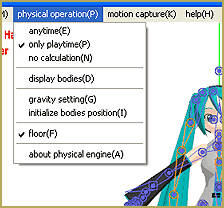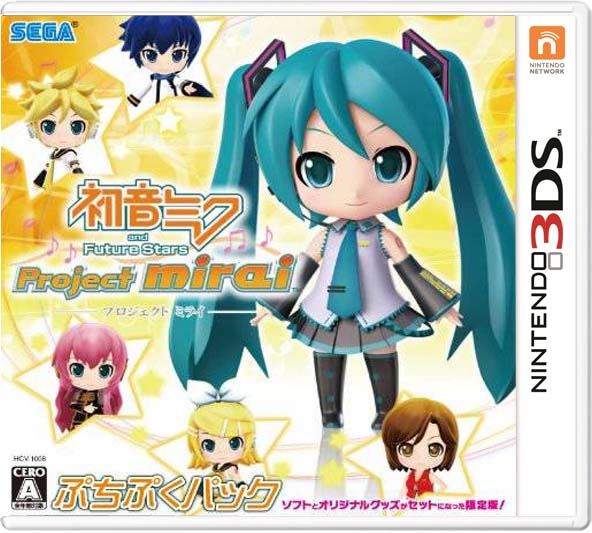Miku Miku Dance Version 7.39
9.31 / December 5, 2017; 2 months ago ( 2017-12-05) Development status Continuing Written in and later Available in English, Japanese, Chinese, Spanish, French Website MikuMikuDance, commonly abbreviated to MMD, is a animation program that lets users animate and create 3D animated movies, originally produced for the character. The MikuMikuDance program itself was programmed by Yu Higuchi (HiguchiM) and has gone through significant upgrades since its creation. Its production was made as part of the VOCALOID Promotion Video Project (VPVP). Contents. Overview The software allows users to import 3D models into a virtual space that can be moved and animated accordingly.
The positioning of the 3D figures can be easily altered, the facial expressions can be altered (as long as the model has morphs to use), and motion data can be applied to the model to make it move. Along with these functions for models, accessories, stages, and backgrounds can be added to create an environment, and effects such as lens flares and AutoLuminous (an effect that makes things glow and light up) can be applied as long as the MikuMikuEffect (MME) plugin is installed into the interface. Sound and music can also be added to create music videos, short films, and fan-made stories.
The motion data used to animate the characters and the pose data mainly used for making screenshots can be exported as.vmd (Vocaloid Motion Data) files and.vpd (Vocaloid Pose Data) files, respectively. The exported files can then be imported into other projects made with software that can use the file types. This allows users to share the data with other users. The software also uses the. Users can also use Microsoft's for motion capturing. Map shadowing, screenshot rendering in several picture file formats and full movie rendering in the.avi file format are also possible.
With the exception of a few models, stages, motion data and accessories that come with the software upon download, all content, including the 3D models, is distributed by the users, meaning all rules and restrictions (or lack thereof) vary greatly from case to case. Most models' rules may be found in its Readme file, which may be a.txt, pdf or a webpage file. The creator, HiguchiM, has stated he can make no promises regarding how other users' fan models can or cannot be used, and is exempt from all responsibility relating to this subject. Models created by other users are often available for public download. As MikuMikuDance is exclusively a posing and animation software, modelers use 3D modeling software, such as or, to create the model and UV map, while the majority of conversion to the MMD platform (such as facial morphs, bones and physical bodies) is done with a program made exclusively for MMD model conversion, PMD Editor or its successor PMX editor. The software itself comes with a small number of models of well-known Vocaloids and an invisible grid, to which particle effects can be attached to in MME, a stage, some accessories, and two samples of what MMD can do, in the form of.pmm files; the file type that MMD projects are saved as. The software was originally only released in Japanese; however an English version was released at a later date.
Videos using the software are regularly seen on sites such as and and are popular among Vocaloid fans and users alike. A magazine which hands out exclusive models with every issue was also produced owing to this popularity. Some models for Vocaloid may also be used for Vocaloid music, going on to be used by studios working with the Vocaloid software. Many people also buy Windows 100% which give models exclusive to the public. These come out once every month and due to popularity, model creators are giving out secret models, as well as the models people have paid for. Most of these tend to be or models that do not have a particular copyright holder. On May 26, 2011, continual updating of the software came to an end and the last version was released.
In a closing statement, the creator left the software in the hands of the fans to continue building upon. Despite this, the source code has not been released, and the developer has no intentions of doing so, making it impossible for people to continue building upon the original software. However, there are alternative programs that provide similar functionality, such as MikuMikuMoving (MMD's 'replacement' that is updated frequently and has many of the features of MMD, as well as new file formats unique to the program, support for the head-mounted display and a new UI, among other features), and the,. Between then and now, there have been several additions to MMD version 7.39, mainly the addition of the x64 version, which runs better than the normal version and is designed to use the power of 64-bit computers that 32-bit computers lack. This results in better performance, faster render times, and higher quality, to name a few. However, on June 1, 2013, MikuMikuDance's creator began to release updates for the program very suddenly. After he began releasing updates again, there have been 18 new versions and the 64-bit versions of them.

MikuMikuDance (MMD) 64-Bit. (HiguchiM) for the Vocaloid(singing voice synthesizer) character Hatsune Miku. Version: 7.39: Category; Category. MikuMikuDance (MMD) free download. Get the latest version now. MikuMikuDance allows you to import 3D models into a virtual work space.
Before June 1, the latest version was 7.39dot, which was released on May 26, 2011. 7.39dot received several program updates between its initial release and the time of ver. 7.39m's release.
Most of these updates were only made to increase compatibility with newer, more advanced.pmx models. It is unknown why the creator began editing the software again.

On December 17th, 2014 version 9.26 has been released which is the most current version. No new updates have been published since this date. In December 2014, announced that they had acquired permission to release MikuMikuDance on.
However, as of February 2018, it has not been released. The first television series to be fully produced with the software, premiered on February 5, 2013. Copyright The software was released as freeware. The models of the Vocaloid mascot series provided with the software are subject to the PiaPro Character License, and are not allowed to be used without permission for commercial reasons. Although the software is distributed freely, models released independently of the software may not be — original produced models, motion data, and landscapes may be subject to their creator's own rules. The program does not standardly include all of the Vocaloid characters, but it includes Hatsune Miku, Kaito, Meiko, and Megurine Luka.
And although the next two characters are not official Vocaloids, they became so popular that Crypton officially licensed and added them to: Yowane Haku, and Akita Neru. References. Notofu (October 23, 2009).
(in Japanese). Retrieved November 15, 2010.
Okada, Yuka (March 10, 2008). (in Japanese). Retrieved November 15, 2010. Vocaloid Promotion Video Project. Retrieved October 2, 2015. March 15, 2008. Retrieved October 2, 2015.
Amazon.co.jp (in Japanese). Retrieved 2 October 2015. Anime News Network.
April 19, 2011. Retrieved October 2, 2015. Mello, Joe (May 29, 2011). Archived from on March 18, 2012. Retrieved October 2, 2015. Retrieved October 2, 2015. (in Japanese).

Retrieved 2 October 2015. MikuMikuDance homepage. Retrieved 2017-06-18.
December 25, 2014. Retrieved December 29, 2014. Anime News Network.
Mmd Models
January 10, 2013. Retrieved October 2, 2015. External links.
Mmd
My new walk test file is cleaner than my previous motion file. See it at. I started by sliding the model back to bit so the toes are on the ruled line. Registered. Then I moved in October 15 frames and advanced the Center and the Left Leg IK to the next line. Registered.I COPIED the Left Leg IK position. Then I went in October 15 frames and pasted que Left Leg IK date. Then I moved the Center and the Right Leg IK out to the next ruled line, registered, and COPIED the Right Leg IK position. Advanced another 15. And so on. This created a nice sliding / skating motion. Then I went back and added some foot and hip action.Go ahead and download this little file and play it for yourself! Get Google SketchUp and the '.X' plug-in for it.